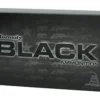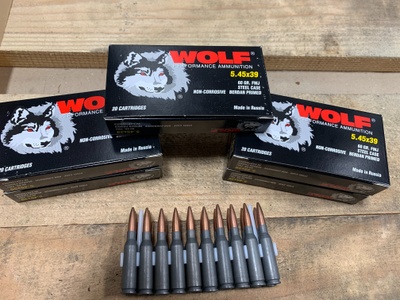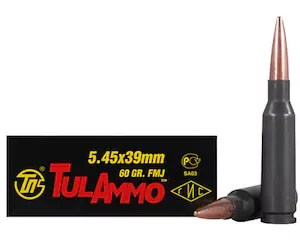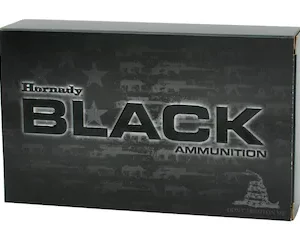CHEAP WOLF 5.45×39 AMMO – 500 ROUNDS – 60 GR – FMJ – STEEL CASE
$220.00
WOLF 5.45×39 AMMO
PRODUCT REVIEW
Wolf 5.45×39 AMMO: 5.45×39 ammo was designed from the ex Soviet Union and adopted by the nation’s Armed Forces in 1974. As an intermediate cartridge, the round has an rimless bottleneck case made of steel which is 39.82mm in length.
The neck of the case is 6.29mm in diameter. the shoulder’s size measures 9.25mm while the diameter of its base is 10 millimeters. The rim measures 1.5mm thick, and it houses an 5.60mm (.22 inches) diameter bullet.
The first Wolf 5.45×39 ammo was weighing between 53 and 54 grains (gr) however, modern variants are typically seen in 60 grams. Although it isn’t as long, the bullet has a length of nearly one inch in length. It has a sharp spitzer tip and a base with a boat-tail.
In contrast to the American custom of lead bullets the Soviet bullet features a light steel core, with a short lead filler that sits over the steel. The nose has a hollow air chamber, which results in greater wounding upon contact.
The entire cartridge has an overall maximum length of 57.00mm and includes the Berdan primer, but rounds are available with a small primer for rifles too. The maximum pressure for the round is 55,114 pounds/square inches (psi).
The 5.45×39 ammo is usually called its military designation 7N6, not the measurements of cartridges.

THE DEVELOPMENT OF Wolf 5.45×39 ammo
The concept behind 5.45×39 ammo Soviet’s design 5.45×39 ammo Soviet didn’t start in the Soviet Union but rather within the United States, when the Armed Forces adopted the M16 in 1964. It was introduced worldwide at the time of the Vietnam War, the M16 auto-gun fired its 5.56x45mm NATO cartridge and, thanks to its tiny size, it was highly effective and deadly.
It was the Soviet Union experienced the receiving ending of M16 along with 5.56x45mm in the Vietnam War and could easily discern the damage that caused by the ammunition. They decided to design their own gun with smaller calibers.
In 1970
In the year 1970, Russian Lieutenant-General Mikhail Kalashnikov who created the famous AK-47 made a smaller caliber automated rifle which was twice more precise than the AK-47 in automatic firing as well as 50 percent more precise in single-shot situations.
Four years after testing, and adjustments After four years of testing and modifications, after four years of testing and modifications, the Soviet Union officially adopted the AK-74 Kalashnikov Avtomat Caliber 5.45mm which is commonly known as the AK-74 in 1974. The design of the automatic rifle was a change based on the larger and older the AK-47. In the same year it was the year that it was the year that Soviet Union released its 5.45x39mm cartridge that could be used in the brand new, light automatic rifle.
In line with using the American 5.56mm cartridge which was designed to replace that of the 7.62×51, the Soviet 5.45×39 ammo was designed to replace an existing cartridge, the 7.62x39mm. One of the major differences between the cartridge made by those of the Soviets in comparison to the cartridge from those in the U.S. is that Soviet designers had to only modify the design of a well-known model (their AK-47) to have an existing rifle which could shoot the cartridge. But, when they adopted the 5.56x45mm cartridge that the U.S. was switching to a completely new rifle platform which had never been tried in combat.
Its AK-74 automated rifle as well as its ammunition witnessed its first time of use in wartime in members of the Soviet Union in Afghanistan during the Soviet-Afghan War, which lasted from 1979 to 1989. In the years since, this gun and ammunition has been utilized in every post-Soviet-Union conflict Russia is involved with. In addition, nearly all nations that were in the Soviet Union use the AK-74 as well as the 5.45x39mm cartridges for the Armed Forces.
In the end of the 1970s there was talk of a lightweight Soviet Union round, but it was not confirmed in the public domain beyond the U.S. military. In the year 1980, a reporter named Galen Geer was working on assignment in Afghanistan in the Soldier of Fortune magazine. He returned with information about the round back to the United States. In the month of October that year, Geer’s piece was published and confirmed stories that had been floating around, allowing American civilians to be informed of the 5.45x39mm Soviet round.
THE ADVANTAGES OF Wolf AMMO 5.45X39MM AMMUNITION
There were many benefits in the Soviet Union’s use M74. M74 for 5.45×39 ammo chambering, including an impressive reduction in ammunition’s weight. It also has a notable diminution in the recoil’s impact in particular when compared with the 7.62x39mm which contributes to it being said that 7.62mm is almost entirely replaced by 5.45×39 ammo.
Recoil tests reveal the 5.45×39 ammo producing the recoil of 2.5 foot pounds force (ft*lb) when fired from the AK-74. The 7.62x39mm cartridge however produces an average recoil of 4.5 feet per second, based on the gun it is fired from.
Along with the reduction in recoil and recoil, the weight of a cartridge itself is significantly reduced with the 5.45×39 ammo. Soldiers may have carried around 180 rounds 7.62×39 in the field of battle, but now , he can carry 270 rounds of 5.45×39 without any noticeable increase in weight.
Another advantage of using Wolf AMMO 5.45mm rounds is the availability of them throughout the United States and around the world. This is because for the past 40 years these cartridges were used in the Russian military as well as the forces of the nations which comprised in the past Soviet Union. Manufacturers of ammunition across the world create ammunition and sell them.
Because they’re simple to locate, shooters can locate affordable Wolf AMMO 5.45×39 ammo in almost every gun store in the U.S. and online. Sometimes even surplus 5.45 ammunition is available and prices range from 20-30 cents for a round.
Many gun enthusiasts swap the uppers on AR-style rifles and carbines to accept their Soviet 7N6 rifle. With the cost of 5.45mm bulk ammunition in certain cases the higher-end cartridge will pay its own way in savings, with just 6,000 to 8,000 rounds.
Like most things, these advantages have a few disadvantages. It is true that the 5.45×39 ammo cartridge is filthy and could cause an accelerated corrosion process of the barrel. If shooting this caliber with any firearm or carbine shooters must wash their guns right after shooting. If this becomes the practice of the shooter, corrosion should be prevented to an absolute low level.
It is important to note the modern ammunition available today’s ammunition can cause less issues than the more traditional military rounds.
PERFORMACE OF Wolf AMMO 5.45X39 MM AMMO
As an illustration of the global military preference for lightweight, small ammunition,5.45×39 ammo has a large muzzle energy. The performance of the cartridge is remarkable with its 49 g powder weight, which enables it to attain muzzle speeds that exceed 3000 feet in a seconds (fps) and produce muzzle energies that exceed 1,400 Ft*lb. These ballistics that are performance-based result from the unique design of the projectile. It minimizes aerodynamic drag, and creates a greater distance, greater retention velocity.
Downrange accuracy is also excellent It has 3.5-inch groups that can be easily achieved at 300 yards. This is extremely impressive for a weapon that is automatic.
In terms of military capabilities the 5.45×39 ammo round can be described as having a remarkable wounding effect. Due to the distinctive dimension, shape and weight in the shot, it has a straight path. However, once it hits its target, it starts to roll, increasing possibility of wounds. It creates huge pores within the wound which makes it more deadly than other rounds with similar dimensions and effectiveness.
In ballistic tests, 5.45mm ammunition exhibits similar expansion to 7.62x39mm however, the smaller bullet expands more quickly. In comparison against the 5.56mm round 5.45×39 is more powerful. 5.45×39 ammo has a deeper impact than the typical round. It is also a frangible army cartridge.
5.45X39MM AMMUNITION VARIANTS
Although the ammunition is made predominantly in Russia according to military specifications, Hornady also makes its 5.45×39 ammo within the U.S. The company encases its cartridges with plastic-overlapping V-MAX bullets, which is a load with high levels of accuracy , which makes it an excellent choice in the hunt for small game.
Wolf Ammunition sells ammunition that is capped that comes with hollow-point bullets (HP), soft point bullets (SP) as well as Full metallic jacket (FMJ) bullets. Bernaul ammunition shoots boat tail bullets and claims their cartridges are reliable and reliable enough to form 100 rounds within less than an centimeter within 100 yards.
Beyond these distinctions in jacketing of projectiles and jacketing, the 5.45×39 ammo cartridge is available with a wide range of military variations which include:
- Enhanced penetrating cartridges: Designated the 7N6M. In which the M indicates “modernized,” enhanced penetration cartridges first appeared in 1987 and come with an iron penetrator that is hardened that allows the projectile to penetrate 6mm steel plate up to 300 meters. The rounds are adorned with red rings at the base of the cartridge to serve as reasons of identification. They’re classified as armor-piercing and in April 2014, they are not legal to import into the United States in Russia. Other cartridges with enhanced penetration are those called the 7N10 (improved penetration) as well as 7N22 (super armour piercing), 7N22 (armour breaking) and 7N24 (super armour piercing). 7N24 (super armor piercing).
- Tracer Cartridges: Multiple tracer cartridges are available with 7T3 and 7T3 as well as the 7T3M. Tracer cartridges include a small explosive charge within the base of the ammunition that, when ignited, produces a bright light. The shooter can clearly see the trajectory of the bullet and adjust the aiming without the need to view the target or the gun’s sights. In battle Tracer cartridges are utilized to inform other shooters how to focus their efforts. Tracer cartridges in 5.45x39mm come with a marked green tip for identification.
- training and instruction cartridges: Used for training and instruction purpose, 5.45x39mm blank cartridges are classified as 7H3,7H3M 7, 7Kh3, and 7H4. Shooters can recognize these rounds as blank by their white plastic bullets.
- Reduced Velocity Cartridges: Called the 7U1 The reduced velocity 5.45×39 ammo is a subsonic ammunition that comes with a projectile weight of 80 grams. The heavy bullet has 994 feet per second (compared to a bullet designed for special use that can go as high as 2,950 FPS) and is a muzzle energy of 176 ft*lbs. The 7U1 comes with an engraved green and black meplat to identify the bullet.
FIREARMS CHAMBERED TO THE 5.45X39MM AMMUNITION
The 5.45×39 ammo was not initially designed for use by civilians however, as the gun proved its value within the military of the Soviet Union and later, it was adopted to civilians. The gun is not as well-liked within the U.S., as it is in other regions of the world, however it is chambered for rifles that use the AR-15 platform, as well as non-AR-style rifles.
The SSG 82, technically called the Scharfschutzengewehr (sharpshooter’s rifle) The 82 is a bolt-action weapon that was developed by East Germany for its special police forces. Only a few were exported across in the United States and little is available about their development.
Made in Russia The VPR 5.45 semi-automatic rifle is a top-quality firearm based in the Kalashnikov design. These guns are specifically designed for use in sporting events and are manufactured by Vyatskie Polyany Machine Building Plant.
It is perhaps one of the most sought-after 5.45×39 ammo firearms sold in the U.S., the Saiga semi-auto in 5.45mm is manufactured from Russia and is regarded as a top-quality rifle that resembles an AK. In order to be imported the firearms are made to have the “sporty” design and transformed once they are in America. U.S. to look more like the original AK-74.
Smith & Wesson also released an AR-style weapon in Wolf AMMO 5.45×39 ammo and the M&P 15R which turned out to be the the first non-5.56mm chambered pistol grip. It was equipped with a 30-round magazine, and was specifically designed to offer AR-style shooters an option that is often less expensive over the traditional .223 ammo or 5.56 NATO. Unfortunately, the firearm is no longer available for sale.
Although it is unlikely to ever surpass the appeal that is 5.56 NATO cartridge, 5.56 NATO cartridge, the round’s low recoil and high accuracy have been able to earn the Warsaw Pact veteran a deserved spot within the American ammunition market for a long time to be.
FAQ
WHAT DO GUNS CAN SHOOT 5.45×39 AMMO?
Its 5.45x39mm cartridge was created by the military of the Soviet Union to be used in conjunction with the AK-74 and replaced the AK-47 chamber that was used for the 7.62x39mm. While the round was not designed for civilian use, it did eventually make its way to the market. Beyond the military rifle, other guns chambered for the 5.45x39mm include the East German Scharfschutzengewehr, the Russian VEPR and Saiga semi-automatic carbines, and the Smith & Wesson M&P 15R (this is no longer in production). A lot of American shooters have rehambered the 5.56x45mm/ .223 Remington AR-style carbines to 5.45x39mm.
WHAT WAS THE REASON WHY THE RUSSIAN ARMY DECIDE TO ADOPT IT? 5.45×39 AMMO?
It is believed that the Soviet Union was inspired to develop the Wolf AMMO 5.45x39mm round following it was revealed that U.S. debuted the 5.56x45mm (the NATO version of the .223 Remington) during the Vietnam War with the M16. After being at the receiving side of the M16 and the M16A1, the Soviets were keen to develop smaller caliber rifle that could be would chamber for 7.62x39mm like the AK-47. Alongside the 5.45 rifle, the Soviets developed the AK-74 carbine, which was much lighter and more precise than the bore rifle with a larger bore.
WHICH AMMO CAUSES MORE HARM WHICH AMMO IS MORE DESTRUCTIVE, OR THE 5.56 AND THE 5.45×39?
If we compare the Soviet 5.45x39mm against that of the American 5.56x45mm, which is the NATO version of the .223 Remington, both cartridges are quite identical. The 5.45 is usually used with a larger projectile, whereas the 5.56 is more likely to have a slight larger muzzle and a higher velocity. energy. Based on their ballistic performance generally, the 5.56 will cause a bit more damage.
WHICH IS MORE EFFECTIVE WHICH IS MORE EFFECTIVE, OR THE 5.45X39MM AND THE .308 WINCHESTER?
If you compare the 5.45x39mm against that of the .308 Winchester, ballistics results show that the .308 is slightly faster in velocity, however, it is more than twice the force exerted by a foot. Due to the increase in energy and velocity, it is more likely to penetrate deeper .308 will penetrate further.
WHAT IS THE REASON 5.45×39 AMMO IS IT CORROSIVE?
Not every 5.45x39mm ammunition is non-corrosive. For example, modern commercial ammunition is generally non-corrosive. The military surplus ammunition is, on the contrary on the other hand, is usually corrosion-prone. This is due to the fact that military ammunition makes use of the Berdan primer. This primer is made up of an ingredient that creates the residue of salt. This salt is hygroscopic meaning it draws water, forming a thin layer of saltwater on the gun. The good news is that it is water-soluble, meaning shooters need to clean the firearm with soapy water to wash away the salt, and then protect it from corrosion.
5.45×39 BALLISTICSCHART: AVERAGE 5.45×39 BALLISTICS
Please note that this information is sourced straight from manufacturers and it is provided for reasons of information only. The actual ballistics that you can get with your gun may differ from the ballistics advertised. In addition, ballistics differ between lots when using identical brands and load.
Be the first to review “CHEAP WOLF 5.45×39 AMMO – 500 ROUNDS – 60 GR – FMJ – STEEL CASE” Cancel reply
Related products
Bulk 5.45x39mm Ammo
TulAmmo Ammunition 5.45x39mm 60 Grain Full Metal Jacket (Bi-Metal) Steel Case Berdan Primed





Reviews
There are no reviews yet.